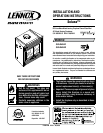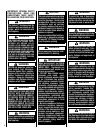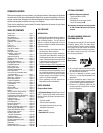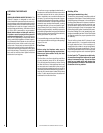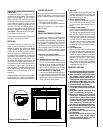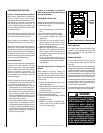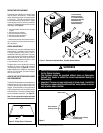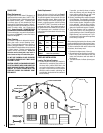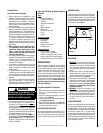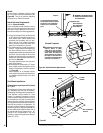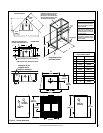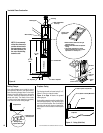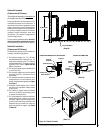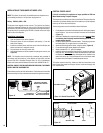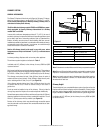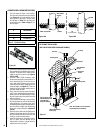
4
NOTE: DIAGRAMS & ILLUSTRATIONS ARE NOT TO SCALE.
Building A Fire
(starting and maintaining a fire)
To start a fire, place several crumpled up balls of
newspaper in the firebox. Place small dry pieces
of kindling on top of the paper, criss-crossing the
kindling so that there are air spaces in between.
Keep the fuel far back enough so that air can
get underneath. Open the air controls fully and
light the newspaper. Once the newspaper and
the kindling is well ignited, close the firescreens.
Once the kindling fire is well established, cord
wood can be added (see How To Use The Outside
Air Register section for proper operation of the
air controls).
The unit will burn best with 2-3 pieces of cord
wood spaced 1/2 to 1 inch apart and allowing
air to get under the fuel. Criss-crossing or ar-
ranging the fuel so that air can get underneath,
will help the fire to get started easily. The unit
should be operated with the air control fully open
long enough to get the cord wood well ignited.
For the Fresh Fire
TM
system to burn efficiently,
air must flow through the bottom of the grate
and up in between the logs. Do not let ashes
stack up to a height which will obstruct the
opening between the base of the firebox and
the bottom of the log retainer.
OPERATING THE FIREPLACE
Fuel
USE SOLID NATURAL WOOD FUEL ONLY. The
Solana™ fireplace is designed to work best
when fueled with seasoned natural wood only.
Hardwoods are preferred to softwoods since the
energy content of wood is relative to its density.
Hardwoods will result in a longer burning fire
and less frequent refueling. A moisture content
of 15% to 20% (seasoned) is recommended.
Wood that has been cut and split and let to
dry under a cover for a period of one year will
usually meet that criteria. The required drying
time will vary depending on the climate. Wood
that is packed tight together will take longer to
dry. Seasoned wood is darker in color than wet
wood and will have visible cracks in the grain
on the ends. Excessively wet wood will be dif-
ficult to burn and will result in lower efficiency,
increased creosoting and deposits on the glass
and in the chimney. Excessively dry wood will
burn well but will also have higher emissions
and shorter burning time.
Do not burn scrap or garbage, treated wood or
wood such as driftwood from the ocean which
has been exposed to salt or other chemicals.
Salt or chemicals can corrode the firebox and
chimney. Do not burn large amounts of paper,
cardboard, Christmas tree branches or building
construction materials. Intense firing with these
materials may overheat the fireplace, causing
damage to the unit, a fire or even possibly ignit-
ing a chimney fire if the chimney is creosoted.
Burning unapproved fuel, resulting in excessive
pollutants being emitted, may be prohibited and
subject to a fine or other penalty by the authority
having jurisdiction in your area.
Processed firelogs can be used. Refer to firelog
warnings and caution markings on the packag-
ing prior to use.
First Fires
Before using the fireplace make sure to
remove the plastic wrapping on plated door.
Remove any glue residue left by the label
using mild soap.
The first five or six fires should be small fires
of short duration (about 30 to 60 minutes).
This will help cure the refractory bricks. During
the first few fires of this appliance there may
be some odor and smoke due to the curing of
the paint, dust accumulation and burning off of
lubricants used in the manufacturing process. It
may set off a smoke alarm located in the same
room. For this reason the room should be well
ventilated for the first few fires.



